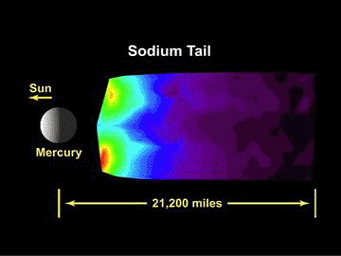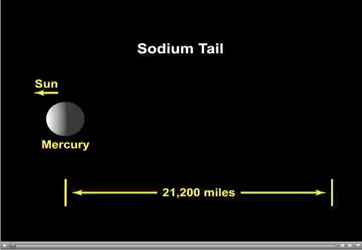
|
A Movie of MESSENGER’s Observations of Mercury’s Exosphere
- Click the image above for a larger view
 Movie Download Options
Movie Download Options- Full-Res JPEG (360 x 270) (8.5 kB)
- Full-Res TIFF (360 x 270) (292.1 kB)
Caption:

Click on the image for the movie
This animation illustrates how MASCS observed the tail region of Mercury's exosphere during the mission's second flyby of the planet. As MESSENGER flew toward Mercury on the inbound leg of its trajectory, the spacecraft rotated back and forth about the Sun-Mercury line. This nodding caused the MASCS instrument viewing direction (i.e., the direction the instrument is pointed) to move alternately north and south, building up an image in a whiskbroom fashion. At two points, the scanning sequence was briefly interrupted while the spacecraft reoriented to take an image; MASCS observations continued during these times, but the observation direction changed. After all the observations were processed, they were then converted to an image of the emission intensity. In these images, the color scale indicates relative intensity as a function of spatial position. Images of the emission intensity of sodium and calcium (see PIA11402 ) have been produced from data acquired during MESSENGER's second Mercury flyby and compared to similar sodium emission intensity measurements from the mission's first Mercury encounter (see PIA11407 ).
Date Acquired:
October 6, 2008
Instrument:
Mercury Atmospheric and Surface Composition Spectrometer (MASCS)
Background Info:
These images are from MESSENGER, a NASA Discovery mission to conduct the first orbital study of the innermost planet, Mercury. For information regarding the use of images, see the MESSENGER image use policy .
Cataloging Keywords:
| Name | Value | Additional Values |
|---|---|---|
| Target | Mercury | |
| System | ||
| Target Type | Planet | |
| Mission | MESSENGER | |
| Instrument Host | MESSENGER | |
| Host Type | Orbiter | |
| Instrument | Mercury Atmospheric and Surface Composition Spectrometer (MASCS) | |
| Detector | ||
| Extra Keywords | Atmosphere, Color, Movie, Rotation | |
| Acquisition Date | ||
| Release Date | 2008-10-31 | |
| Date in Caption | 2008-10-06 | |
| Image Credit | NASA/Johns Hopkins University Applied Physics Laboratory/Carnegie Institution of Washington | |
| Source | photojournal.jpl.nasa.gov/catalog/PIA11415 | |
| Identifier | PIA11415 | |
